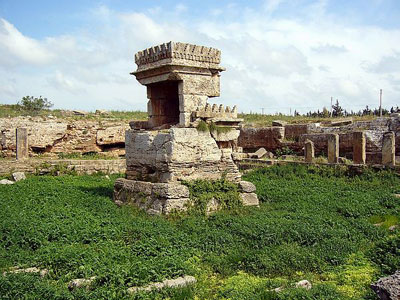
The city lies on the Mediterranean coast around 6 kilometers (3.7 mi) south of modern-day Tartus. Two rivers cross the city: Nahr Amrit, near the main temple, and Nahr al-Kuble near the secondary temple, a fact that might be linked to the importance of water in the religious traditions in Amrit. The city was probably founded by the Arvadites, and served as their continental base. It grew to be one of the wealthiest towns in the dominion of Arwad. The city surrendered, along with Arwad, to Alexander the Great in 333 BC. During Seleucid times the town, known as Marathus, was probably larger and more prosperous than Arwad. In 219 BC Amrit gained independence from Arwad, and was later sacked by forces from the latter city in 148 BC.
Excavations of the site principally began in 1860 by Ernest Renan. Excavations were again carried out in 1954 by the archaeologist Maurice Dunand. Ceramic ware finds at Amrit indicated the site had been inhabited as early as the third millennium BC. Middle and Late Bronze Age “silo tombs” were also excavated, with contents ranging from weapons to original human remains. Excavations at the necropolis south of the town yielded several tomb structures. The funeral art found in some tombs with pyramidal-or cube-shaped towers, is considered some of “the most notable grave-monuments of the Phoenician world.” Excavations also uncovered the town’s ancient harbor, and a U-shaped stadium that dates back to the 4th and 3rd centuries BC and measures around 230 metres (750 ft) in length.
One of the most important excavations at Amrit was the Phoenician temple, commonly referred to the “ma’abed,” dedicated to the god Melqart of Tyre and Eshmun. The colonnaded temple, excavated between 1955 and 1957, consists of a large court cut out of rock measuring 47×49 metres (154×161 ft) and over 3 metres (9.8 ft) deep, surrounded by a covered portico. In the center of the court a well-preserved cube-shaped cella stands.] The open-air courtyard was filled with the waters of a local, traditionally sacred spring, a unique feature of this site. The temple dated back to the late 4th century BC shows major Achaemenid influence in its layout and decoration. According to Dutch archaeologist, Peter Akkermans, the temple is the “best-preserved monumental structure from the Phoenician homeland.”
A second temple, described by visitors to the site in 1743 and 1860 and thought to have disappeared, was later discovered by the Syrian archaeological mission near the Nahr al-Kuble spring.
Compiled by:Maysa Wasouf

